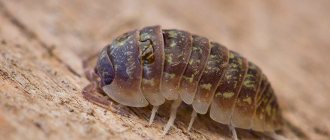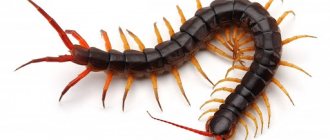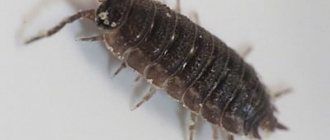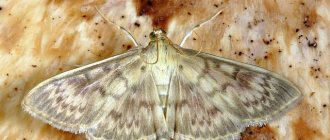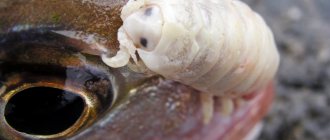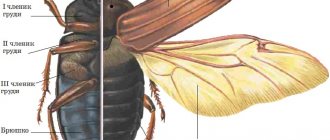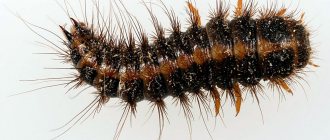A member of the crustacean family, the woodlice insect is considered a pest that adapts well to a wide variety of conditions. It can be found everywhere: in basements, greenhouses, apartments, country houses and garden plots. They are rarely seen during the day because they are predominantly nocturnal.
What does a woodlice insect look like?
Looking at what a woodlice looks like, many feel disgust and disgust. It has an oval, slightly flattened body with an arched silhouette, consisting of many segments. On the back of the insect, the woodlice has plates colored in shades from gray to brown, depending on the species. The usual body size is 2 cm or a little more, but in nature there are giant individuals whose sizes reach up to 30 cm in length.
Trachelipus rathkei
This species does not have a Russian name, but this does not mean that it is not found in Russia.
It can be seen quite often in central Russia. According to statistics, they appear in large flocks precisely in those places where there are a lot of buildings and buildings. They adapt quite quickly to their habitat and are not very picky about the conditions in which they find themselves. This type of crustacean is quite difficult to catch, since it is at the bottom of their body that the shell expands slightly, which complicates the catching procedure.
Trachelipus rathkei can be found in large quantities not only in Russia, but also in the United States, Europe and Canada.
What do woodlice eat?
Upon closer examination of the insect's life, it begins to seem that woodlice are omnivorous, because they find food wherever they appear. In many ways, what woodlice eat depends on where they live.
- In the kitchen
: leftover food in trash cans and condensation on water pipes. - In the bathroom
: toilet paper, mucus, soap scum, mold. - On a personal plot
: roots and shoots of young plants, and liquid in columns and wells as moisture. - In the apartment
: leaves and shoots of indoor plants and food debris. - In attics and basements
: vegetables stored for the winter, crustaceans that grow in damp places. - In nature
: moss, bark, rotten remains of insects, shoots and roots of young plants.
Features of life
Woodlice love high humidity . During the day they hide in shelters: in earthen burrows, under stones and loose bark, in a pile of fallen leaves and in damp rooms.
Land crustaceans are unpretentious when it comes to food . At night they feed on organic debris: rotten wood, rotting vegetation, fungal spores on plants, and when there is a shortage of food, their own excrement. Woodlice themselves are rarely eaten by birds; more often they serve as food for spiders, toads and lizards.
Woodlice live for about a year and breed in April-May, mainly at night. For this purpose, females form a special brood chamber filled with liquid. Fertilized eggs enter it, and offspring subsequently appear there. Young individuals leave the brood compartment already well developed. During the process of maturation, they molt several times.
Woodlice insect - benefits and harm
Absolutely all living organisms on our planet, even if they are parasites, are part of the overall ecosystem, therefore, along with obvious harm, they also bring some benefit. This also applies to woodlice insects, which like to gather in colonies. In order to balance their probable benefits and obvious harm, it is worth considering in more detail why wood lice are dangerous and what are the advantages of their existence.
Damage from woodlice:
- Eating living plant leaves, sprouts and seeds.
- Violation of the integrity of the root system is why wood lice are primarily dangerous for plants.
- Compaction of the soil, which leads to its depletion of oxygen.
Benefits of woodlice:
- When their numbers are small, they are useful for indoor plants, enriching the soil with the products of their vital activity.
- Eating rot makes them some kind of orderlies, processing what is already subject to decomposition. Even in the basement and cellar, they will feed only on rotten vegetables, without causing harm to whole ones.
- The specificity of their digestive system makes them excellent cleaners. Woodlice in the bathroom, for example, feeds on dirt (particles of toilet paper, human waste products, mold).
- Some species feed on small insects, such as ticks, which are harmful to humans.
General information
At the moment, science knows 3600 species of woodlice , living all over the world both on land and in water. Woodlice are the ancestors of crustaceans that developed in an aquatic environment and then moved to land. Certain species have adapted to different habitats, thanks to which they can survive in any conditions (what do woodlice look like?). Their durable shell, like a shield, provides a reliable barrier from external factors (temperature and pressure changes). The only condition that prevents their existence is a dry microclimate. Woodlice always need a moist environment, otherwise they dry out and die. Insects are omnivores.
Their digestive system can digest waste from other animals and insects, cellulose, and even some poisons. Woodlice reproduce quickly. Females lay eggs at a rate of 30 eggs per day. The queen stores the eggs in a special bag on her body until they are opened. The size of individuals at birth is about 2 mm.
Woodlice are most often spotted in the fall. Habitat: damp and dark areas of the house , as well as under stones in gardens and vegetable gardens. As soon as the cold weather sets in, they move indoors in search of a warm place. Woodlice will stay where it is warm and wet. Food and other conditions play a secondary role.
Attention! Woodlice are not a pest - they damage property, do not attack people, and do not steal food. Only occasionally can they feed on the roots or leaves of flowers. But the scale will be very small. 1 gram of sugar is enough for woodlice to eat for several months.
We talked in detail about whether wood lice are dangerous for humans and why in a separate article.
Are woodlice dangerous for humans?
The appearance of insects is not pleasant and many, when they see them, experience not only disgust, but also fear, especially if they do not know whether woodlice bite or not. We hasten to reassure you, wood lice in an apartment or house are not dangerous for humans. They don't bite because their mouthparts are not designed to do so. They are saprophages, feeding only on organic decay products. The only danger that the woodlice insect poses is the likelihood of carrying pathogens of infectious diseases on its legs.
Reviews
1. Are these woodlice (crustaceans with clearly more than 6 legs) or sugar silverfish, which are also often called woodlice (no more than 7 mm, a “tail” of three “strings”, 6 legs, silver color)? 2. if these are woodlice, then as long as there is a source of dampness, it will be almost impossible to get rid of them. They don’t start out of nowhere on their own. It is quite obvious to me that they were there before, but apparently the wet area was very small. Another unpleasant nuance: wood lice respect rotting wood and fungi. Be sure to look for a place where this can happen - they don’t feed on the Holy Spirit! sad.gif One thing is consoling: unlike flies and cockroaches, woodlice do not carry any dangerous diseases. However, their large number indicates the corresponding presence of organic matter, which they feed on. Yes, that’s it, take it off, peel it off, treat it with anti-rot and fungus, and dry it thoroughly. You don't have to kill the spiders - they will help control the number of woodlice. wink.gif But you can’t kill them with chemicals - they are nocturnal animals with a specific diet, they are buried in crevices...
jungarik
https://www.kid.ru/forummam6/t30693.html
While they are only in the bathroom, it is necessary to take urgent measures so that the horror movie does not repeat itself in your place. Here's my experience. “They” crawl into the bathtub from the sewer through the drain holes (bottom, overflow and in the sink). They don’t crawl out in the kitchen, because they wash dishes there with hot water several times a day. Why they don’t crawl out in the restroom, I don’t know. Our bath is dry and clean, but nevertheless “they” ran into the bath to get a drink. I plugged all 3 holes and only opened them to wash myself. With metal locker. The taps are not dripping. After washing, the water was thoroughly dried. The dryness became incredible. After two days of dry hunger strike, only dried remains remained. The question was what to do next. Tired of endlessly shutting up. I soldered mesh cups instead of plugs, but they became clogged and required washing. I decided to pour in bleach so that the chlorine gas in the cramped pipe would suffocate “them.” Household supply stores sell cheap bleach diluted with water, called “bleach.” But then he changed his mind and decided to destroy them with very hot water. We have a gas water heater. He adjusted the water so that you instantly pulled your hand back and poured the water in for an hour - kitchen - bath - bath overflow - sink. And he felt the cast iron fan pipes. They gradually became very hot, so “they” were unable to hide from the hot water at the top of the pipes. - very hot. After a while, “they” will appear, but I already know how to meet “them.”
good bye
https://www.e1.ru/talk/forum/read.php?f=159&t=5823
people! Find out better where you constantly have dampness. Eliminate the dampness and they will go away on their own. Unless of course the house is old and damp from floor to ceiling.....
tanita
https://www.e1.ru/talk/forum/read.php?f=159&t=5823
Hello. I also want to share my experience. We bought an apartment on the 5th floor in a 5-story building. The house is renovated, clean. I moved there and in the evening I’m getting ready to go to bed and I hear some rustling of the roofing felt under the wallpaper or under the ceiling tiles. I turned off the light and then I saw woodlice climbing up the wall and I became very scared. and so I heard their rustling all night. It’s just terrible that I went to work, exhausted and sleep-deprived. I bought an odorless repellent for cockroaches and sprayed it all over the ceiling along the baseboards and under, so they fell on the floor all night, I just had time to collect them, I don’t know, I hope I’ll get rid of them.
Guest
https://www.woman.ru/rest/medley8/thread/3831584/3/#m39324316
Types of woodlice
There are about 3,600 species in nature, but we will consider only those that are most often found in our region. These species of woodlice have successfully adapted to exist in temperate climates.
- Common armadillo
. Feeds on plant foods. The color of the scaly body is dark, has 18 pairs of paws and a pair of antennae. - Armadillidium vulgare
. Armadillos live where there is a lot of their favorite food: rhizomes, rotted leaves and shrubs. This species is also called “rolls” because in moments of danger, like hedgehogs, they curl up into a ball, protecting their internal organs. - Centipede
. This species feeds mainly on insects. Its poison is safe for humans, but can cause allergies. - Silverfish
. This is a small species that feeds on insects, including mites. - Porcellio scaber
. This insect is also called “woodlice.” This species is one of the smallest and most numerous. - Marine
. They live mainly in water, eating garbage and various biological waste. The body length of the marine species reaches 20 mm.
Who in the wild eats these crustaceans?
But no matter how lurking wood lice are, they are an indispensable link in food chains
. And in the face of a significant threat, their chitinous shell and ability to curl up do not help them out. They will become fairly easy prey for the following predators:
Small crustaceans are considered a favorite food for residents of artificial ecosystems, for example, terrariums. They are bred as food for spiders, snakes, and lizards. They are not that nutritious, but they can make changes to the diet of domestic predators. There are no problems with direct breeding of crustaceans; they are not capricious either to food or to the microclimate.
How to deal with woodlice in the garden?
Before getting rid of woodlice on your site, it is worth considering the safest and most effective options in order to choose the most appropriate one. You also need to know that woodlice live in places of high humidity, so first you should reduce watering, if this is possible and will not particularly harm the crop. To get rid of these pests, ready-made preparations are used, but an important condition for their use is compliance with the proportions specified in the instructions. The most effective chemical agents:
- "Schabenge"l;
- "Mole";
- "Varan";
- "Ideal";
- "Thunder-2".
Folk remedy for woodlice in the garden
Folk remedies have also proven themselves well. Many people do not resort to chemicals because simple and affordable methods of control are often effective.
- Boric acid for woodlice
. Prepare a solution (10 g per 500 ml of warm water) and spray problem areas. The acid destroys the chitinous shell of insects, and they die. - Traps
. A good remedy for wood lice that does not require time or money. In places where pests accumulate, damp rags are laid out at night, under which by morning you can find a lot of woodlice.
Chemical remedies
You can also get rid of domestic woodlice using industrial chemicals.
Here are the most effective of them:
"Avalon" is a series of insecticides produced in South Korea. There is a different remedy for each type of pest, pay attention! It has shown itself to be effective in the fight against parasites if all rules of use are followed.
Aerosols
Aerosols, of course, will give a positive result much faster than traditional methods. The active substance of the drugs is strong insecticides. However, maximum benefit can be obtained by using the product in a limited space. That is, it is good if wood lice concentrate in the bathroom, toilet or kitchen.
The most effective aerosols include:
- "Tarax" deservedly takes its place among the leading drugs. The film that forms after spraying is poisonous and first paralyzes arthropods, and then their death occurs.
- “Dichlorvos Varan” (universal - acts on any insects and various living creatures for 20 minutes after spraying. It is odorless, but must be used in sufficiently large quantities.
- "Tetrix" belongs to a series of concentrated preparations, sprayed around the apartment in small quantities. It is effective, but does not act immediately, therefore, as practice shows, repeated treatment of the apartment is required.
- “Dichlorvos (Eco and Neo)”, “Combat”, “Clean House”, “Raptor” and others are aerosols that are very successful in destroying woodlice.
Solutions prepared from concentrates
To obtain the solution, high concentration insecticides are used. The drugs are diluted in water according to the instructions. The prepared mixture is poured into a spray bottle and surface treatment begins. The products are so effective that some of the ones proposed below are used by pest control services.
Most Popular:
- "Tetrix" and "Cifox".
- "Taran" and "Xulat Micro".
- "Cucaracha" and "Delta Zone".
New developments are becoming increasingly popular - microencapsulated drugs with increased efficiency and extended duration of action:
- "Get" and "Lambda Zone".
- "Xulat" and "Tarax".
Dusts and powders
As for dusts and powders, their purpose is to be scattered around the perimeter of rooms, kitchens, etc., poured under baseboards, into corners and crevices to combat woodlice. Despite the fact that insecticidal powders are powerful means of exterminating pests, they have one small drawback - the impossibility of applying them to walls. This means that some arthropods (and probably a considerable number) will escape along vertical surfaces. To avoid such situations, powdered formulations are used in a duet or trio with other products. But the effect of such a combination is amazing.
Well proven:
- "Riapan" and "Phenaxin".
- "Neopin" and dust "Clean House".
Pencils (crayons)
Special pencils are easy, convenient and fast. They will be an excellent solution for small rooms. Using insecticidal chalk, draw lines where woodlice will sooner or later get caught. The peculiarity of land crustaceans is their flat bodies, and it is this body structure that leads to the adhesion of poisonous substances to them in large quantities. Subsequently, this, of course, leads to the death of woodlice. In addition, using a special pencil, you can block the paths for pests to enter the apartment - draw a kind of “border” (around sockets, ventilation outlets, etc.). Even if annoying creatures violate it, they will already be doomed to death. The most popular insecticidal chalk among housewives is “Mashenka” and its analogue “Titanic”.
How to get rid of woodlice in a greenhouse?
Before destroying woodlice in greenhouses and greenhouses, as in the case of a vegetable garden, you should try to exclude watering. These insects do not survive in dry places. If this is not possible, then you can use some tips.
- 3 g of red pepper, salt and tobacco are dissolved in a liter of water and the insect habitats are generously sprayed. It is better to artificially create a place of high humidity in the greenhouse and then treat it with a solution.
- Spraying with vinegar is good for pest control.
- Potato trap is a simple and effective method. Core the potatoes and leave overnight. By morning, a cluster of woodlice can be found in the vegetable.
Folk remedies
- Chlorine (solution of 50 ml per 1 liter of water).
- Boric acid (solution of 2 g per 0.5 liters of water).
- A mixture of dry tobacco, soda and red pepper (the ingredients are mixed in the proportion of 100 g of tobacco: 1 packet of pepper: 2 tablespoons of soda per 1 liter of water).
- Dry kvass (solution of 100 g per 1 liter of boiling water).
- Quicklime (place several containers indoors and leave for 3 days; you must leave the house during this time).
Woodlice in the apartment - reasons for its appearance
To live, these insects require a lot of moisture and food, so more often than usual, if they settle in an apartment, then in the bathroom, toilet and, less often, in the kitchen. Among the most common reasons why wood lice come from in an apartment:
- increased humidity in the room;
- untimely cleaning of housing and ventilation;
- cracks in the floor, walls and communications of water supply and heating pipes;
- Many indoor plants contribute to the appearance of woodlice, which like to gather in flower beds, where it is always humid.
Preventive measures
Prevention is based on following three simple rules.
- Purity. We take out the trash on time. We make sure that dirty dishes are not left on kitchen surfaces. Floors and walls are periodically washed well, especially in hard-to-reach places. We monitor the cleanliness of flower trays and flowerpots.
- Humidity. We don’t accumulate mountains of wet clothes, linen, towels. We regularly ventilate the premises. We use air drying devices. We ventilate things on the balcony. We check the functionality of the climate control equipment. We clean ventilation pipes and grilles. We fix plumbing breakdowns in a timely manner.
- Moves. If there are cracks and crevices in the floor or walls, we use polyurethane foam and sealant. If the wallpaper falls off, quickly glue it back up.
Woodlice are a kind of indicator that shows the condition of the apartment. Their presence indicates a low level of cleanliness and hygiene in the premises.
Cleaning
Throw away old sponges, napkins, mats, and trash. Wipe down all surfaces, including walls, under sinks, bathtubs, and the bathroom fixtures themselves. It is better to do this with some detergent. It is not necessary to repeat this cleaning every day. Once a week or a little less often is enough.
Dry the bathroom and keep it in that condition. After using the shower or sink, wipe up spills on the floor, wall, and surrounding objects. Try to follow this rule at least once a day. Check all pipes for damage and replace leaking areas. The slightest leak will delay the process for a long time.
Access limitation
How to remove woodlice from the bathroom and toilet so that they do not appear again? One of the most effective means is to seal all the cracks and cover the ventilation with a fine mesh. Fix any leaks and inspect the floor and walls for cracks. If there are any, seal them with silicone sealant. Also close the gaps between the bathtub, sink and wall. Gaps in water pipes can be sealed with alabaster or foam. Perhaps the source of the invasion is not in your apartment. Inspect the ventilation mesh - are there any holes in it?
Creating a favorable microclimate
Leave the bathroom door open and ventilate the apartment after each water procedure or at night. Check if the ventilation is working well. This can be done using a paper strip. Open the windows and door, hold the leaf to the hood. If it sticks to the hole, then everything is fine. Having a heated towel rail or heater on helps a lot - their heat will dry the water faster. If possible, avoid drying large amounts of clothing indoors.
Porcellio spinicornis
This species of crustacean is quite famous in Europe and has recently been seen in North America. This id of crustaceans is slightly different in appearance: they have yellow spots on the top of the shell, as well as antennae of three segments, long and quite strongly curved at the corners of each segment.
Porcellio spinicornis gravitates very strongly to places with the presence of limestone or lime. Most often, this species is found near chalk quarries, in houses made of foam concrete or in old churches with walls whitewashed with lime.
